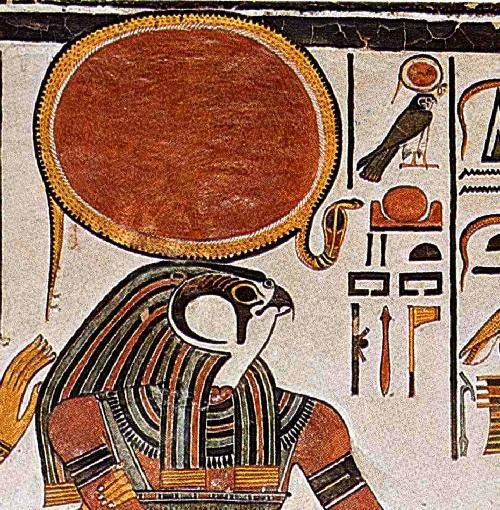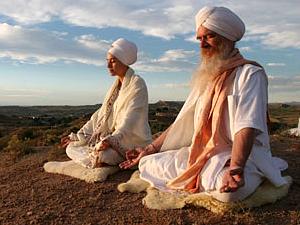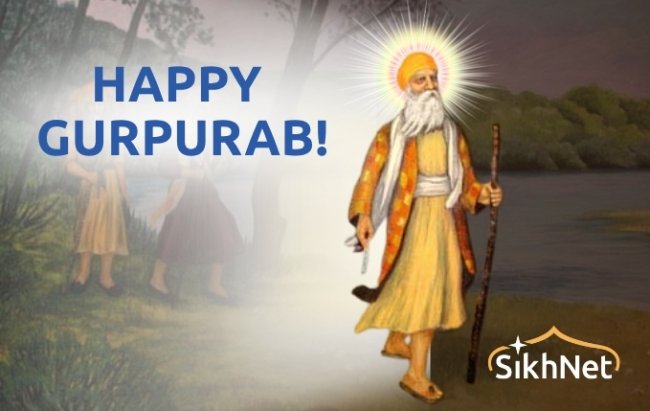As mentioned earlier, the word Kundalini means the coil of hair on the head of the Beloved. It has been portrayed throughout history as a snake, and later came to be known as the coiled serpent of potential energy and consciousness which lies at the base of the spine waiting to be awakened.
 The serpent halo of the Egyptian god Hourus shows the kundalini rising. The well-known symbol of the caduceus shows the kundalini energy rising through the ida, pingala and the central channel, the sushmana. Even the inlay art in the Sach Khand Gurdwara on the roof of Harmandir Sahib shows the kundalini cobra rising.
The serpent halo of the Egyptian god Hourus shows the kundalini rising. The well-known symbol of the caduceus shows the kundalini energy rising through the ida, pingala and the central channel, the sushmana. Even the inlay art in the Sach Khand Gurdwara on the roof of Harmandir Sahib shows the kundalini cobra rising.
The activation of the chakras and the heightened level of consciousness that occurs as the kundalini energy rises and opens the chakras gives one the sensation of dawning within, awakening or rebirth.
One of the earliest methods used was to wind the hair into a knot at the top of the head. This knot or joora was know as a ‘rishi knot’ since it was used by the yogis and rishis. This knot then acts as an amplifier and transformer between the finite, personal life and the infinite, impersonal ocean of consciousness. As Sikhs we adopted this practice with full understanding of its purpose, although now, many forget that purpose.
Yoga means ‘union’ and it is not one particular series of practices, although it is now understood that way, but it is actually a state of consciousness – union of the atma and the Parmatma. This state of ‘yog’ – union with the One - is referred to many times in the Siri Guru Granth Sahib.
 Our body and mind are wired for spiritual experience. The ability to pierce through the veil of maya is within each one of us. From the soil of devotion and longing sprouts the seed of awareness, but it must be watered and cultivated. By using the technology of body posture, breathing rhythm and mantra (Naam Simran) we can change our state of awareness.
Our body and mind are wired for spiritual experience. The ability to pierce through the veil of maya is within each one of us. From the soil of devotion and longing sprouts the seed of awareness, but it must be watered and cultivated. By using the technology of body posture, breathing rhythm and mantra (Naam Simran) we can change our state of awareness.
Awakening the Kundalini, the uncurling of the coiled energy, is not big deal - since for life to exist in us, it must already be active, though dormant. Moments of deeper awakening do happen in life but we do not always know either what contributed to this awakening or how to sustain it. One’s kundalini can rise in the Sadhsangat and one’s kundalini can rise by falling on one’s bottom. But Kundalini yoga developed as a systematic method of expanding consciousness and maintaining the new awareness.
The Guru lies within each of us. It is the compass needle that always points true north – the touchstone of Truth – the conscience of every individual. Though the Guru is always present, we do not always listen to that voice within ourselves. The practice of Naam Simran in the company of like-minded individuals (the Sadhsangat) makes that voice become more powerful within us.
It is regular practice of Naam Simran which is naturally integrated with the yogic practices of asana, deep breathing, and relaxation which will gradually raise awareness and induce calmness and crystal clarity within us.
The technology of Kundalini Yoga is readily available from many teachers around the world and there are many resources available on the Web as well, including videos as well as written instructions.
It is our heartfelt prayer that the whole world may be blessed to awaken to the experience of Naam Simran and to the Guru that lies within all of us.
Waheguru!
Bibliography:
1. Meditation and Spiritual life by Swami Yatiswarananda; Ramkrishna Math, Bangalore 6th. Reprint 2001.
2. Bandginama by S Raghbir Singh September 3, 2001. This book can be downloaded from Internet
3. Links Present Sikh Student Camp Pamphlet-Chapter on Kundalini Yoga.
4.Websites: www.sikhstudent.org and www.sikhnet.com; Search for Simran and you can access articles, videos and lectures on Simran by Gursikhs and Yogi Harbhajan Singh Ji.
5. Way of the Saffron Cloud by Bhai Dr Kulwant Singh. How to recite the Name of God. A spiritual treatise for the uplift of the humanity. This is the practical help-book to guide in the recitation of the Name of the Akal Purukh.
6. Autobiography of Sant Baba Harnam Singh; An equally inspirational autobiography of one of the most famous saints of recent times
7. Boss Sikh Camp pamphlet 2004 on Simran or Remembrance of God.
BACK <-- Part 1 - Part 2 - Part 3

